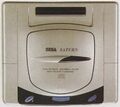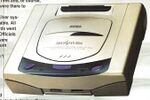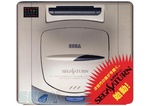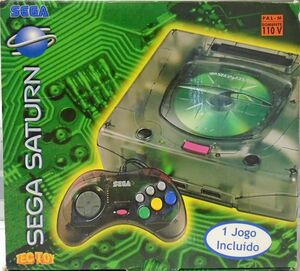History of the Sega Saturn
From Sega Retro
Contents
Development
Rumours of a successor to the Sega Mega Drive emerged as early as 1991, with the arrival and subsequent rise of Nintendo's Super Famicom in Japan. The Super Famicom, later to become the Super Nintendo Entertainment System (or SNES) in western markets, was considered by much of the press to be the superior machine from a technical standpoint, prompting suggestions that Sega may have attempted to leapfrog its competition at the earliest possible opportunity.
The industry was still relatively young and the concept of a console "cycle" had not yet fully been explored, and the arrival of the Sega Mega-CD put the question of a successor to bed for several months. However, in 1993 the situation was different - threats of the Atari Jaguar, CD-i and 3DO were putting strain on the Mega Drive's 16-bit image in the West, and in Japan, the system simply had not taken off, and so, talk of brand a new console began to make the headlines - "project Saturn".
Pre-announcement
A 27-member group known as the Away Team, began development of the "Saturn" project - a CD-based gaming system to carry the company forward. Away Team was composed of Sega employees from a wide range of specialties, including hardware engineering, product development, and marketing, and was headed by Hideki Sato, who had also been responsible for designing Sega's prior "main" consoles. The team worked roughly two years on the project exclusively, in an attempt to get the console to launch with the some of the world's best hardware and software of the era.
Throughout much of 1993, nobody knew what project Saturn entailed, though from the start it seemed likely that the successor to the Mega Drive would be a "32-bit" or "64-bit" system utilising a CD-ROM drive and possibly offering a cartridge option (though no Mega Drive backwards compatibility). It was often difficult to envision the future - Virtua Racing and later Virtua Fighter gave clues about what 3D gaming from Sega could look like, but expectations were raised when Namco demonstrated its texture-mapped arcade racing game, Ridge Racer at the Amusement Machine Show 1993.
On September 21st, 1993, Sega announced a joint venture with Hitachi with the intention of producing a "32-bit" video game multimedia machine, the idea being that Hitachi would be responsble for producing the processor.
By February 1994, talk of the Saturn was well under way, with developers supposedly receving extremely early hardware reported to be vastly superior to the Amiga CD32, Atari Jaguar and 3DO, as well as Virtua Racing. It was thought to be more in-line with Sega's Daytona project (the corporation's answer to Ridge Racer), though these comparisons with Sega Model 2 hardware were often generous to the Saturn. Furthermore, Virtua Racing actually has a higher polygon count than Daytona, but because the polygons are not texture-mapped (which, incidentally was technology provided by Lockheed Martin, not Sega), the game looks less "realistic".
Edge magazine issue #5 states that the Saturn had a SH7032 CPU RISC chip running at 27MHz as its main processor, 3MB of RAM (which suggests a lack of VDP2 chip), "32 audio channels" (with support for PCM and FM) and a release date of November 1994. The final model opts for two SH-2 processors, with the SH-1 reduced to controlling the CD-ROM drive.
Coincidentally, Sony's "PlayStation X" or "PS-X" project was in a similar situation to the Saturn, though most commentators, including Sega, suggested the PS-X would be the more powerful system. Most notably, Namco pledged their allegiance to the hardware early on, with the aim of bringing Ridge Racer to this new home platform relatively unscathed.
Concepts
US Opinion
Tom Kalinske was reportedly never impressed by the plans for Saturn hardware, but Sega of Japan refused to give the American branch of Sega much say in regards to the console's development. Kalinske did not see the Saturn as a console that could sell in the region in its current form - it was not engineered in such a way that would appease western developers, and he was fearful that the competition would eat into Sega's market share relatively quickly (at numerous points in the first half of the 1990s, the Mega Drive (or Genesis) was the best selling home video game console in North America).
Silicon Graphics
Kalinske even went so far at one stage to source out an alternative graphics chip, approaching James H. Clark of Silicon Graphics (SGI), who, along with the recently acquired MIPS Computer Systems, were working together to create a low-cost real-time 3D graphics system. Negotaions fell through - though Sega of America were positive about the project, Sega of Japan were not keen, with the company collectively evaluating an early prototype as having several unresolved hardware-issues and deficiencies which made the project too risky. Sega would have also demanded exclusive rights to the upcoming chip, while SGI wanted to license the technology to other vendors.
The Silicon Graphics deal is controversial, not least because it was picked up by Nintendo for use in the Nintendo 64 in the Summer of 1993.
Sony Deal
Having been more-or-less rejected by Nintendo, Sony Electronic Publishing turned to Sega of America for help get into the console race. The PlayStation project (or what would become the PlayStation) was not thought highly of by Sony executives in Japan (a view which would not change until E3 1995), and Sega of America, reportedly impressed by the PlayStation project were keen to get Sony on board to create a Sony-Sega console. Japan once again rejected the idea based on Sony's perceived inexperience, however Sony Imagesoft, along with Sega of America would work with Digital Pictures to test out CD-based game development prior to the deal's collapse.
Inevitably Sony would hire Steve Race who was working under Tom Kalinske at the time and challenge Sega head-on at E3 1995.
Winter CES 1994
First public viewings of Project Saturn emerged at Winter CES 1994, held in January, but it was not the focus of Sega's efforts, being shown extremely briefly on a marketing loop with many Mega Drive and Mega-CD titles. No details of the hardware were mentioned, just a rolling demo of five potential Saturn games - Virtua Fighters and Daytona GP (using arcade footage) and three early tech demos - Virtua Soccer, "action game" (Clockwork Knight) and "3D shooting game" (Panzer Dragoon).
The console itself resembled something very similar to the final product, but was partially obscured by darkness and not rendered in full colour. It may not have even been a physical product at this stage, just a glorified piece of concept art.
Jupiter and Mars
Alongside project Saturn, Sega were working on a project Jupiter - a cartridge-based 32-bit system. The main difference between the two was a CD-ROM drive - at one point, the Saturn set to be able to run cartridge as well as disc-based software, with the cartridge port later being downgraded into a feature which would "assist" games. The Jupiter project was essentially a Saturn without a CD-ROM drive, but could have been upgraded at a later stage to create a makeshift Saturn console.
By February 1994 the Jupiter had been publically axed and in its place, the ill-concieved "project Mars", headed by Sega of America. Seemingly unaware of the upcoming Saturn hardware, the project, later known as the Sega 32X, set itself the task of extending the Mega Drive's lifespan, first as a true successor to the system, then as a hold-over to the Saturn. As a result, many early Sega "32-bit" projects have a confused development history - some were converted into Saturn games, others were mislabeled as Saturn software, and many projects were never completed.
The 32X created a great deal of customer divide - it was an expensive and cumbersome unit, incompatible with the Saturn and was supported for less than two years. In most of the world the unit debuted before the Saturn, however in Japan it arrived some months after, damaging both consumer confidence and future Saturn sales.
The Saturn project started too early to learn from the 32X's mistakes - it too was considered a cumbersome machine from an early stage of development, most notably from Tom Kalinske, CEO of Sega of America at the time. It was upgraded several times during development - the final product being a great deal more powerful (but inherently more awkward to work with) than originally planned.
Nevertheless the 32X's history begins later in the year, and at no point seems to have influenced the Saturn's general direction from a development point of view. It's announcement, however, caused a stir amongst the press and consumers, most knowing that maintaining two systems would be untennable going forward.
Consumer Group Show Spring 1994
March 1994 is where Japanese consumers could "see" a real Sega Saturn. A handful of hardware photos and a logo were sent to the press, while TBS Television aired footage of the Saturn at Sega's R&D labs. Hayao Nakayama had the honor of revealing the system to the world, though as it transpires, the Saturn on display was merely a painted shell constructed out of wood.
Nevertheless, footage showed prototype Saturn hardware running Virtua Fighter.
The Saturn model on display was much like the final Japanese HST-0001 console, spare for one key difference - it was silver as opposed to grey. Also printed on the unit was the text "High Performance CD-ROM/Cartridge Entertainment System", suggesting that cartridge-based software was still being considered at this stage.
Tokyo Toy Show 1994
The Toyko Toy Show 1994, held on the 2nd of June 1994, finally let people use the console. Though mostly complete in design, the Saturn hardware had yet to be condensed into its final form, and while a Saturn console was put on display, this consisted solely of a plastic shell. Alongside the Saturn, prototype control pads and Virtua Sticks were put on display, with both undergoing cosmetic changes before release.
The event featured a number of early Saturn games, although with the exception of a 30% complete build of Virtua Fighter (according to Electronic Gaming Monthly magazine), most were said to be unplayable. Technical demos featuring content from what would emerge as Daytona USA were featured, and Clockwork Knight also showed up in some form. Many games were announced, but much of the attention went to Sony's PlayStation, now in its near-final incarnation.
EGM reported that the Saturn was due to retail at ¥49,800 or less, would have two SH-2 32-bit RISC CPUs, have a Motorola 68000 chip driving the sound and could handle 16.77 million colours. Flat shading, gourard shading and texture mapping were all set for 3D models, and scaling, warping and rotation were set for sprites. Five layers of scrolling were available for 2D graphics, and 32-channel PCM and 8-channel FM audio were available. These figures suggest that the hardware was roughly the same as the final Saturn model, though with some figures missing, there is the possibility of slight differences. The final cost of the Saturn in Japan was ¥44,800, reduced primarily to compete with the PlayStation.
This Saturn is very similar to the previous one but now has its final logo, even if the shell is still silver.
It is also notable that the Saturn's launch was deliberately delayed around this period for Western markets - a strategy ensuring the console would have more software at launch, as in both the Saturn and PlayStation's case, third-party support had yet to pick up.
Final Design
Towards the end of 1994, having spent much of the year focusing on the 32X instead of the Saturn, Sega of Japan announced a final tweak to the console's aesthetics, claiming their new grey model was more universal than the silver of before (though it is thought that in reality, the silver scratched too easily). It was at this point where the deals with Hitachi and JVC came in, with the concept of manufacturers making their own Saturns, similar to the plans of the now struggling 3DO console.
Hitachi also owned their own retail outlets at the time, so it was an excuse to get the Saturn onto more store shelves in Japan.
At the second CSG show of the year, the Saturn's release date was finalised for the 22nd of November - eight days before the previously announced PlayStation date.
Release
Japan
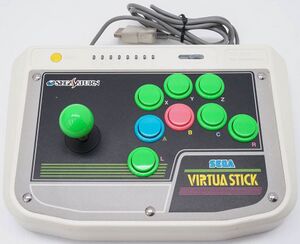
Having been designed in Japan for a predominantly Japanese audience, it is perhaps no surprise that the Sega Saturn would do well in the territory. It is thought that roughly 500,000 consoles were ready to be sold on launch day (1994-11-22), but Sega specifically held back on 300,000 in storage for a week, in an attempt to catch a fledgling PlayStation off guard. Sony shipped around 100,000 consoles to Japanese retailers for its launch on December the 3rd - Sega sold at least 170,000 Saturns in its first day of sale - its most successful console launch of all time.
Very few games were available when the Saturn launched — Sega's Virtua Fighter (packed-in with the system), Sega/Micronet's WanChai Connection, Electronic Arts Victor's Mahjong Goku Tenjiku, Sunsoft's port of Myst, and Time Warner Interactive's Tama. Some elements to the Saturn's early praise were down to experience - initial PlayStation controllers had short leads, while a Saturn one was 7ft. Pre-orders had effectively sold out two weeks in advance (having only been available for a month), and queues for the system were several hours long, and so staff dressed as Sega's "coneheads" (characters seen in early Saturn advertising) had been brought in to keep order.
JVC's V-Saturn was also made available, but was considerably harder to find.
By the end of Christmas 1994, 500,000 Saturns had been sold (including 50,000 V-Saturns) versus the 300,000 of the PlayStation, topping the market over the period. Sega were planning to triple that figure by Christmas 1995 at 1.5 million units, with an additional 180,000 V-Saturns in play.
Part of the Saturn's continuing success was due to strong, inspiring adverts featuring Segata Sanshiro, who would travel around Japan and punish those who did not play their Saturns. While Saturn systems were being outsold by PlayStation systems for much of its lifespan, Sega actually sold more software for the Saturn during 1995-1997. The result was that in Japan the Saturn became the platform of choice for more dedicated gamers while the PlayStation had an audience comprised of more casual customers who bought fewer titles.
While the Sega 32X had the potential to do damage to the Saturn brand, in Japan the Mega Drive add-on was dismissed out of hand, and was killed within the year. Furthermore virtually all Mega Drive and Mega-CD game production ended on the Saturn's launch - while games continued to show until early 1996, it was clear the older console was being sidelined.
One million units had been sold in the territory by mid-1995, but Sony were able to slowly catch up and overtake this figure, due in part to lower licensing fees and a 7-10 day lead time versus the 10-12 weeks experienced in the days of cartridges. However, the Saturn again outsold its competitors during Christmas 1995, thanks in part to the so called "big three"; Virtua Fighter 2, Sega Rally Championship and Virtua Cop. Sega felt that about 50% more Saturns were being sold than PlayStations during the first half of 1996, and a Spring price drop cemented this point further.
The Nintendo 64 landed in September of 1996, lacking the fanfare of the then-record Super Famicom launch and, in a surprise twist, generally failing to meet Japanese expectations. The system continued to do well, only faltering by the middle of 1997 when Sega's entire corporate structure seemingly went into meltdown, with frustrations in the US and a failed merger with Bandai making the news for the wrong reasons, and the ongoing trials and tribulations of the "Saturn 2" project - a console the Japanese didn't really need.
Japan had numerous Saturn models available within its lifespan of varying colours. It can be seen as one of the first systems to offer a choice in colour - a practise that would later be expanded on further by the Nintendo 64.
In the end the vast majority of the Saturn's game library remained exclusive to Japanese customers. More than 80% of the console's 1000+ strong library did not leave the country.
All this considered, the Sega Saturn is widely regarded as the most popular Sega platform of all time in Japan, selling more than the also-popular Nintendo 64 (6 million vs. 5.54 million). The console was supported with software until 2000, almost two years after the Dreamcast launched in that region.
North America
With perceived weaknesses both inside and outside of Sega of America, the Saturn had a tough time outside of Japan. The press were intrigued, if not ecstatic about the console's arrival and many were questioning the long-term future of the 32X, which already seemed to be on its way out.
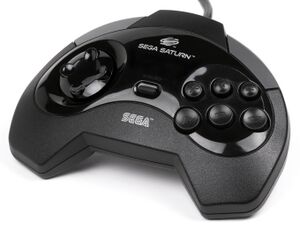
With the Sega Mega Drive (Genesis) and its add-ons, Sega had become the dominant player in the so-called North American "console wars". It had beaten rival Nintendo during the Christmas period for three years in a row (1992, 1993 and 1994) and was predicting equally strong growth in 1995, holding about 55% of both the hardware and software market in the region at the time.
Before word of the PlayStation's earlier release, the release day in the US was to be 'Saturnday' on September 2, 1995 - delayed to ensure the console had games at launch. However, following Japanese worries at E3 1995, the Saturn was released four months ahead of the schedule - on the very day of Sega's E3 press conference. The timing was not great - not only did Sony turn around some hours later to annouce a lower price point ($299 vs. $399), the early Saturn release surprised everybody - not just consumers and developers, but retailers too. This pricing move, along with much better marketing than that of Sega of America, wreaked havoc on the Saturn's place in the market and ultimately caused its downfall.
The American branch did not have enough stock or enough games to justifty the early launch - many retailers were left alienated (most notably Kay-Bee Toys) because console supplies were too low (which meant Sega had to prioritise some stores over others), and with the PlayStation seen to have dominated E3, enthusiasm for the Saturn was low. Not only did the announcement of an early release take third-party software developers by surprise, it also meant that Sony would have more time to put some finishing touches on their PlayStation, draw up a well-planned strategy and learn from the pitfalls of the Saturn.
Third party developers had no time to get their games translated and out to market by launch, leading to a severe drought of games which plagued the system for its first year. The early launch was in a sense, meaningless, as few games launched on the Saturn ahead of their originally planned schedules, and many games which did see a release were considered by many to be under-par.
Perhaps the biggest contribution to the initial Saturn's failure was the distrust that gaming consumers were developing for Sega after a series of add-on peripherals to the Sega Mega Drive (Genesis in the US), the Mega CD and 32X, which were discontinued around the same period as the Saturn's launch after only lukewarm support. The PlayStation also had many more popular software titles much earlier in the race than Sega did, such as ports of Namco's Ridge Racer which was technologically superior to Sega's Saturn release of Daytona USA, despite being the simpler of the two arcade releases.
Sega forecasted that 600,000 Saturns would be sold in the US, but there were a number of factors causing headaches for the firm. For one, it is thought the Saturn cost roughly $380 to produce (versus the $300 or so for the PlayStation), and Sega had misjudged the public's enthusiasim over a $400 "next generation" console, many of whom were waiting to see how Sony would respond. In the end, 80,000 Saturn units were sold in North America before the PlayStation, but 100,000 PlayStation units were sold within its first few days.
Even the 3DO is thought to have out-sold the Saturn in this initial four month period, it too being priced around $100 cheaper, and by the end of 1995 it was even worse - the PlayStation was out-selling the Saturn 2:1 - 800,000 units versus 400,000 in the territory. There is very little way of telling exactly what the situation was in North America afterwards - both Sony and Sega were reluctant to disclose official numbers and both were thought to be inflating the figures. Commentators suggested the PlayStation may have been out-selling the Saturn at a rate of 4:1, but it could have easily been as high as 6:1 or even 12:1.
Sega was no longer top of the Christmas charts, and as well as being beaten by rival 32-bit machines, a surprisingly strong comeback from the SNES meant that Nintendo sold more 16-bit consoles too. It was in early 1996 when to counteract some of their losses, Sega pulled the plug on both the Sega 32X and Sega Nomad. The product line was effectively reduced to three; the Mega Drive (Genesis), the Game Gear and the Saturn.
But this gap between the PlayStation and Saturn continued to wide and would never be closed. The press and public gradually became more disinterested in Sega's efforts, and eyes turned to the delayed Nintendo 64, thought now to be the only upcoming machine capable of challenging Sony's dominance. Sega tried a marketing push with the NetLink in the following year - the first genuine attempt to marry a video game console with internet capabilities, but it too failed to catch on.
E3 1996 saw the PlayStation drop its price to $199, to which the Saturn was forced to follow, despite being more expensive to manufacture. In September, the Nintendo 64 launched putting more pressure on the Saturn, however in what was considered an act of desperation, the Saturn's fortunes turned with the announcement of the 3 Free Games deal, popular enough to warrant extensions past its holiday timeframe and keep the console firmly in the race for another few months.
1996 ended with the Saturn on approximately 1.6 million console sales in the US, out-gunned by the Nintendo 64 which had shifted 1.7 million within three months, and half that of the PlayStation, which was estimated to have sold 3.2 million in the region. Nintendo's strong start was countered by a PlayStation price cut to $149.95 in early 1997. Meanwhile, talk about new consoles was engulfing Sega, awkwardly headded by new Sega of America CEO, Bernie Stolar, who openly talked down the Saturn at E3 1997.
The Saturn owned roughly 15% of the market at this time, but by the Summer, third-party publishers were pulling out of the project and the console's prospects seemed grim.
Over time, Sega also changed its marketing strategy, and the successful rebellious advertising campaign of the Sega Mega Drive (for example, the Sega Scream television commercials) was toned down and exchanged for advertisements which took on a more conservative attitude.
Sega's flagship character and mascot, Sonic the Hedgehog, never made a particularly major Saturn appearance - an enhanced Mega Drive port, a racing game and a compilation of his major Mega Drive adventures were made, but only the racing game was exclusive and it was hardly a major title. In fact, the one truly major title (Sonic X-treme) wound up being canceled.
Unfortunately, many of the games that made the Saturn so popular in Japan such as the Sakura Taisen series or many of the quirky anime style RPGs that sold well in Japan were never released elsewhere. Much of the reasoning behind this was due to policies put in place under the management of former Sega of America president Bernie Stolar, who believed that RPGs were never to have great commercial success in North America.
Europe
Success in Europe is difficult to quantify, as Sega's marketing and distribution channels varied considerably between the constituent countries of the continent. Unlike the Sega Mega Drive, however, Sega Europe had a handle of the four major European markets, the United Kingdom, France, Germany and Spain from the outset. Giochi Preziosi continued with Italian distribution and the system was catered for in smaller countries too, but the Saturn marks a period where country-wide plans converged on a single "European" strategy.
As such, the Sega Saturn was launched across Sega's definition of Europe in July 1995, a few months before the September launch of the PlayStation. The console was welcomed at first, and while sales were always behind that of Sony, it continued to receive widespread support until Christmas 1996.
Sony's strategy in Europe was far different from all those which had come before, and were the first console platform holder to treat Europe as an equal partner, rather than an afterthought by companies such as Nintendo. As such, PlayStation adoption was high, and Sega were forced to openly adopt a "quality over quantity" approach. Much like North America, however, interest in the Saturn steadily declined, third-party support was lost over the course of 1997 and the console effectively bowed-out by 1998.
Sega's console was kept in the UK race by the very well written Sega Saturn Magazine, with November 1998's Deep Fear being the last game to be released in this region.
Unlike previous consoles which require physical mod chips, the Saturn simply requires an Action Replay cartridge in order to run software from overseas. This made importing games from Japan a much easier process.
Brazil
Like previous consoles, the Sega Saturn was distributed by Tectoy, and eventually adopted many of the colour schemes set out by Sega of Japan. Though not a commercial failure fewer Saturn games were released than Master System or Mega Drive games, with a vast number being US imports.
South Korea
The Saturn was also released in South Korea by Samsung as the SamsungSaturn (삼성새턴). It is rumoured that there are at least two revisions of the console - original models had a faulty reset button which did not function.
Asia
Much like previous consoles, the Saturn had a patchy release across Asia, seeing a release in nations such as Thailand and Hong Kong. A special Saturn with VCD support was released in this "region".
Decline
In many ways the Saturn was on the back-foot from day one. While significant volumes of Virtua Fighter were sold during its first few months of sale in Japan, it was a game not without its criticism, with many citing the game's "glitchy polygons", possibly caused by a rushed development timeline but more likely a lack of understanding of how to effectively render 3D graphics on the hardware.
It is a common misconception that the Sega Saturn was developed to be a 2D games machine. While it is certainly true that it handles 2D graphics better than much of its competition, every Sega game demonstrated on the hardware during its development - even in Japan where the 3D craze was not as significant - utilised real-time 3D graphics, and were pushed as selling points of the system. It was, however, very difficult for third-parties to meet expectations during its first six months of sale, leading to Sega AM2's Tadahiro Kawamura creating the Sega Graphics Library (SGL), under orders to ease arcade-to-Saturn conversions by Yu Suzuki.
By mid-1995 the old Sega Saturn Programming Boxes were replaced with cheaper CartDev units, and shipped to developers alongside an SGI Indy workstation, Softimage, SNASM2 and AM2's new SGL software. In a sense this meant that while Saturn development was technically feasible, prior to this date developers were forced to do a great deal of hardware research and library building of their own, slowing down game development considerably.
After the holiday shopping season in 1996, the Saturn had fallen behind the PlayStation and Nintendo 64 in North America and Europe, and Sega of America's senior management wanted to produce a new platform pretty quickly. The idea was to get the jump on the next generation of systems ahead of their competitors, and so by E3 1997 Sega had already begun talk of the new system, code named Katana, which would eventually turn into the Sega Dreamcast.
As Sega started aggressively moving the Katana project forward it caused something of a rift between Sega and many third party developers. The Saturn was more than holding its own in the Japanese marketplace where the vast majority of Sega game development was based. As a result many Japanese developers saw little to no reason for Sega to rush another platform to the market, which would in the process, effectively kill the Saturn despite its large user base and many active development projects.
After another third place turnout during the Holiday season in 1997 a number of third party publishers started cancelling titles, as a result many games planned for a US Saturn release, including renowned titles such as Policenauts and Lunar The Silver Star Story. A chain reaction of cancellations rushed through the Saturn market transforming a seemingly promising 1998 schedule of North American releases to a small handful of titles.
In Europe, particularly in the UK, the Saturn held its own for roughly the same period of time, continuing a long running trend of supporting aging or comparitively weaker systems well into old age. However, rising development costs, awkward hardware and low sales forced publishers like Eidos to reconsider their policies, and similar to North America, the Saturn began to be dropped by third-parties during 1997 and 1998. Difficulties with Saturn development created numerous problems for the European market - many top games like Wipeout and Destruction Derby were released many months after their PlayStation counterparts while some such as Micro Machines V3 were never released at all.
The Saturn would be discontinued in late 1998 for Europe, and April 3, 1999 in North America. Sega's history would damage the Dreamcast's reputation, with notable publishers such as Electronic Arts refusing to back the system, having made losses on the Saturn. It is widely considered that the Saturn was simply not up to the task of competing effectively in the fifth generation of video game consoles - it was not a machine built for 3D games, yet this was the expected standard throughout the latter half of the 90s.
In the end, 9.5 million Saturn consoles were sold worldwide, with the console faring worse than both the PlayStation and the Nintendo 64 (despite the latter arriving more than a year late). In Japan, the Saturn out-sold the Nintendo 64 by a considerable margin (though still lagged behind the PlayStation), and the system enjoyed some, albeit muted, success in smaller markets.
Aftermath
Lessons
3D graphics
While strong in representing 2D video games, the Saturn is considered to be ill-equipped for the world of 3D gaming born in the mid-1990s. When it was designed, 3D games were still a novelty and texture-mapped polygons even rarer, however by 1997 3D was no longer the just the future, but indeed very much the present. 2D gaming was seen as a thing of the past - something associated with "16-bit" consoles of the Mega Drive and Super Nintendo, not the $300+ 32-bit powerhouses. There was an expectation that platform holders would offer something truly new for the price, but the Saturn is not thought to have fully delivered on its promises.
While the Saturn frequently benefited from the experimental period of early 3D gaming (quadrilateral-based polygons (which the Saturn employed) were for a while, just as widely used as the triangle-based model of the PlayStation and later consoles (so in some cases, Saturn ports fared better than their PlayStation counterparts)), it was on the wrong side of the argument in many respects and ultimately failed to keep pace with technology. With the Dreamcast, Sega sided with graphics specialists and adopted more mainstream ideas and formats.
Untapped processing power
In mid 1995, Sega AM2 were demonstrating prototypes of Virtua Fighter 2 running at 704x480 at 60FPS, suggesting the capability was there to produce very competitive Saturn titles. However, AM2 were among the most skilled developers within the organisation and were very familiar with the hardware - third-parties rarely matched these statistics, and were unable to utilise the hardware fully.
The design of the Saturn was complex compared to the PlayStation, with various different processors (Sega of America claimed there were three, but there are arguably more) all being used in tandem. AM2 wrote and released various development libraries to assist in Saturn development, but for months these were considered inadequate. The Saturn was the last mainstream video game console to favour assembly language over higher level programming languages such as C - while there were many holdover specialists from the Mega Drive and Super Nintendo days, it was significantly harder and more time consuming to get promising results out of the Saturn.
As a result, most multi-platform games 3D fare worse than their PlayStation counterparts. Simplified development tools were a priority for the Dreamcast, and the addition of Windows CE theoretically allowed Windows programmers to easily adapt to the console.
Legacy
Though the Sega Saturn is not amongst the most fondly remembered video game consoles, it is still considered noteworthy. The 3D Control Pad set the standard for analogue control pads going forward, introducing the concept of analogue shoulder triggers and a thumbstick on the left hand side of the controller (something continued with the Dreamcast and later the Xbox line). Its six face buttons also made its controllers ideal for fighting games.


